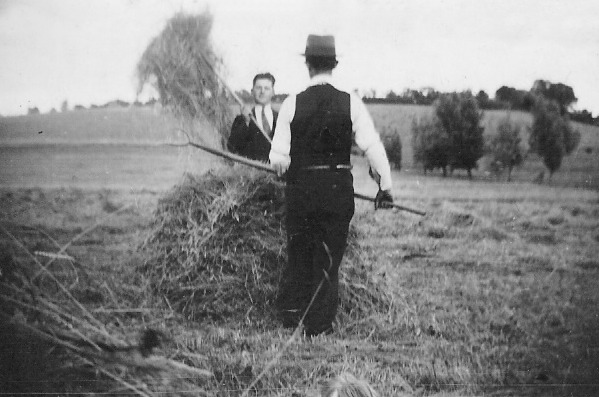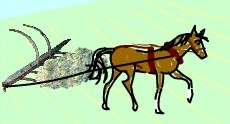![]()
One of the things I remember most about my summers in Ireland
was making hay. Around 1950, haymaking hadn't progressed much for 1,000 years,
except that a mower had replaced the sickle. About the time you got out of school
for the summer, the farmers started making hay around early July. Timing was critical.
Farmers watched the sky, listened to the weatherman, and then took their chances.
So volatile were the changes in the weather in Ireland, that making hay was so risky
that it was often referred to as 'saving the hay'. They would need three
good days of drying weather. Before you knew it, a mowing machine would show up
in the farmer's field next to our home. Sometimes it was a tractor towing a
mowing machine, with one person on the tractor, and someone on the mower, to lift
and lower the cutting blade, or it was a horse drawn mower. In later years, a mower
that was integrated with the tractor became available, thanks to Harry Ferguson,
using his famous and patented three-point hitch.
If the grass was cut early in the morning, we could be in the field that afternoon,
turning it. Turning was done best by using a rake. This was a wooden tool, with
wooden pegs for teeth. Since the mower laid down the hay in the form of a swath,
you could give it a tug at the right place and at the right angle, and you could
go around the field rolling over the hay at close to walking pace. That was the
job for Charlie, the farmer's son, my younger brother Herb and me. When you
did it together with others, conducting a lively conversation as you went, time
flew. A dead frog or a bee's nest provided a distraction here and there.
In less than a day we were back in the same field shaking it out. This was a job
for a two-prong fork, and was more time consuming. Often clumps would have to be
well shaken out so that the sun and the wind could do its job. Sometimes if you
were cursed with a rain shower you might have to shake out the hay a second time.
Around 1954, the local farmer got himself a brand new 'shaker' to tow behind
his tractor to do this labour-intensive work.

My father and grandfather making hay.
On the third day the hay was usually ready to make into haycocks.
Here's where the hayrake, towed after the tractor, went to work and deposited
the hay where you wanted to make the haycock. A rope connected from the rake to
the tractor was pulled at the right time by the driver. The best spots were on high
ground. You started collecting hay into a pile about six to seven feet in diameter.
When the pile was three to four feet high someone got on top of the pile and started 'building'
the haycock. Around the age of fifteen, I worked my way up from hay-gatherer to
haycock-builder. With a rake in hand, I would stand on top of the mound of hay,
reach out fully with the rake, and pull it into my feet before someone accidentally
stabbed me in the legs with their pitchfork. I would shake the hay out well around
my feet, lifting my feet and tucking some hay under my feet as I went. Little did
I know that all these techniques would be those used in the random-laid non-woven
technology used to replace knitted fabrics. If you didn't do this, you would
hear from farmer Bob and you wouldn't make a 'good haycock'. You probably
would fall or slide off before completion. Others would pull loose hay all the way
around the bottom of the cock. Another important job was going around the haycock
with a rake and raking it into the proper shape. This was farmer Bob's job,
in addition to directing the operation. Bob was like a broken record with, 'Move
your feet. Don't just stand there. Shake it around. Tuck some under your feet.'
I hear him still.
When you had tapered the haycock off to a peak, you knew it. It was now time to
get off, or fall off. But first, you needed to tie the haycock down. One rope would
be thrown through your legs as you straddled the peak, and then tied down. Then
another rope at 90 degrees diagonally. Now you could dismount. With someone holding
the haycock with a rake, you would slide down the haycock feet first ever so gently.
Hope-fully it remained standing. If it didn't then you wouldn't hear the
end of it from farmer Bob.
As late as 1950, I remember that the ropes used to tie off the haycock were made
of hay, by two people, with one person using a twisting tool, and the other feeding
hay in the right amount as it was twisted. With the coming of the baler, and its
baler twine, grass rope was on its way out.
If the hayfield was distant from the farmhouse, the farmer's wife, Annie, would
bring tea in two large baskets to the field. 'Come on, let's eat, an empty
bag can't stand,' farmer Bob would say. There was always a favorite for
everyone, sandwiches of lettuce, tomato, scallions, banana, jam, roast beef, or
ham, and of course, wheaten bread and plenty of tea. The exact menu depended on
whether Annie had been to town recently. Sometimes Charlie would challenge me to
one of his favourites, 'stabs'. We sat on the grass, facing each other,
feet against each other's, both holding on to the handle of a pitch-fork. Charlie
easily pulled me over his head. When I got older, around seventeen, I had more strength
in my arms, legs, and back, and we had longer-lasting duels. When every-one had
enough, Bob would stand up and say, 'We're not going to get this hay made
this way', thereby signalling us all back to work.
Sounds in the hayfield in those days ranged from the corncrake getting out of the
way of the mower, to the cuckoo in the distance, probably eating some other bird's
eggs and laying her own as she sang her famous song.
Around 1950 1 remember helping my Grandfather and Uncle George make their hay. They
had a donkey and a rake called a 'tumbling-paddy', a unique contraption
made of wood, probably invented in Ireland or Scotland around 1850. As a young boy
of age ten, it was fun learning how to operate it, having it pulled by a donkey,
which often had a mind of its own. The tumbling-paddy was really a large comb, with
handles. You took off with the comb horizontal, picking up whatever :hay was in
its way. When it was full, you steered the donkey towards the haycock. At the right
time you jerked upon the handles. The front teeth got stuck in the ground, and with
the donkey continuing to pull, the tumbling-paddy would tumble over, deposit its
load of hay, and right itself ready to go after another load. You had to watch not
to get hit with the teeth as it tumbled, and then you had to jump over the pile
of hay just deposited. This was a very simple tool that put man and beast to work
in a wonderful way. I was intrigued by it. I wonder who invented it, if it was patented
at all.
Later on, I found out that over in the U.S.A., around 1850 someone invented a wooden
rake, called 'the revolving rake'. The teeth of it turned half a revolution
each time. It was more complicated. The tumbling paddy design doesn't appear
to have been used in North America, probably because of NIH (not invented here).
Both designs became obsolete when the steel rake came along, with curved teeth (tines)
big wheels, and a tripping mechanism.

The tumbling paddy. Youtube link > http://www.youtube.com/watch?v=TZ0-krtOm7s&feature=youtu.be
The concept of making haycocks and leaving them out on the field
to dry further and to 'weather' was a good one in one sense. In the event
that the hay in any haycock had not been dry enough when the haycock was made, this
dampness would cause bacteria to grow rapidly, and in turn would generate so much
heat that the haycock would catch on fire. Better that one haycock perish in the
field than a whole barn and its contents go up in smoke. I learned this from Charlie
next door, after I questioned him as to why he would stick his arm into a haycock,
up to his elbow, as we walked past his haycocks. He was checking to make sure there
were no high temperatures or mildew type smells that would mean big trouble.
By late August, it was time to bring the haycocks into the hayshed. Here's where
the 'hayshifter' was used, with its tiltbed. In a tilted mode, the hayshifter
was backed into and under the haycock as far as it would go. The winch at the front
of the hayshifter incorporated a ratchet mechanism with a release so that cables
can be pulled off and placed around the haycock and clasped together. Then the haycock
would be winched onto the body of the hayshifter using a hand-crank, a lever, or
a turning wheel, with the ratchet now in the proper position. When the haycock was
about halfway on, the tiltbed would drop to the horizontal position and lock in
this position for safe travel to the farmyard. With a bit of luck, there was enough
room at the back for us kids to sit, on the way home. Of course, you had to keep
your legs up, so you wouldn't get hurt by getting your feet caught between the
uneven ground and the hayshifter, as it bounced in and out of the ruts. Going for
rides on the hayshifter was something we loved to do with Tommy Morrow, because
his hayshifter was horse drawn. His field was close by over the 'Bark Loanin'.
Such were the actions that the farmer and his family took to make hay, so that in
the winter his animals could be fed. Within ten years, making hay would never be
the same again, with hayshakers, windrowers, and balers, box and roll type, making
the process very easy. Also, making silage started gaining more and more popularity.
The Taylors up the Farra road made silage. However, to those who knew haymaking
as it once was, even though it was work, it was also a celebrated reunion time for
family and friends, and a yearly tradition that we all looked forward to. Alas,
no more.
![]()